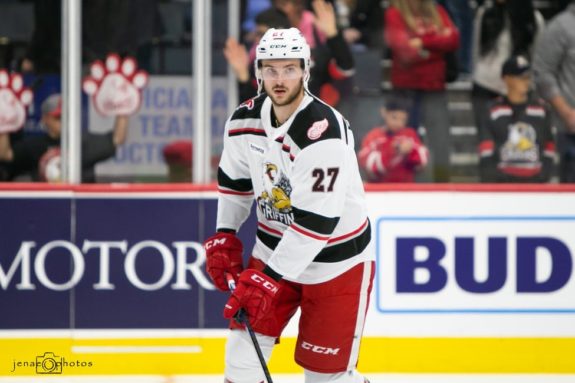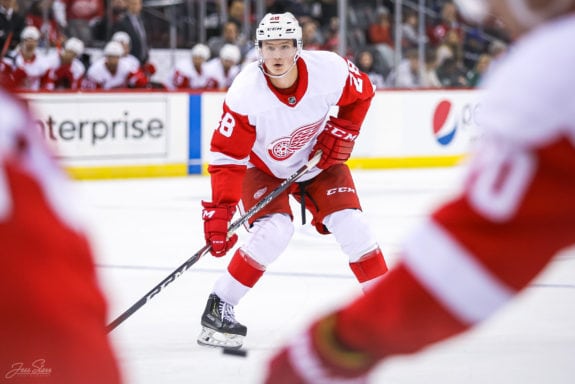
 Tony Wolak
The Hockey Writers
Tony Wolak
The Hockey Writers
41
Reads
0
Comments
Red Wings 2017 Draft Class: Expectation vs. Reality
When the Detroit Red Wings finished the 2016-17 season with the sixth-worst record, the expectation was that they would be able to draft a cornerstone player for their much-anticipated rebuild. Expectations remained high even after the Red Wings were dealt a tough hand and received the ninth pick in the draft, with three better teams jumping them in the draft order.
But as we’ve come to realize—especially in the era of social media—expectation rarely equals reality. And that was indeed the case for Detroit’s 2017 draft class.
Red Wings 2017 Draft Class
Here’s how Detroit’s 2017 draft picks fared in their third seasons with the franchise:
| Prospect | Pos | 2019-20 Stats | 2019-20 Team(s) |
| Michael Rasmussen | C | 35 GP – 7 G – 15 A – 22 PTS | Grand Rapids (AHL) |
| Gustav Lindstrom | RD | 45 GP – 0 G – 5 A – 5 PTS | Grand Rapids (AHL) |
| Kasper Kotkansalo | LD | 34 GP – 0 G – 8 A – 8 PTS | Boston U. (NCAA) |
| Keith Petruzzelli | G | 34 GP – 2.01 GAA – .920 SV% | Quinnipiac (NCAA) |
| Malte Setkov | LD | 29 GP – 1 G – 2 A – 3 PTS 25 GP – 5 G – 5 A – 10 PTS | Malmo (SHL) Kristianstads IK (Allsvenskan) |
| Jack Adams | C | 0 GP – 0 G – 0 A – 0 PTS | Union College (NCAA) |
Rasmussen’s Future with the Red Wings
Since Detroit drafted Michael Rasmussen, the forward has been a polarizing figure amongst Red Wings fans and hockey analysts. He’s either a center or a wing. He’s either a top-six, offensive center or a bottom-six role player. Why can’t Rasmussen be all of the above?

Depending on how the Red Wings fill out the rest of their prospect pipeline, Rasmussen can slot into the lineup in a variety of ways. And that’s a good thing. Sure, it’s reasonable to expect that a team’s first lottery pick in a generation should be a top-line difference-maker. That’s just not the case with Rasmussen. At best, he’s an impactful second-line forward. And at worst, he’s an above-average shutdown center on the third line. Plus, he’s going to be a nuisance in front of the net on the power play regardless of where he slots in at five-on-five.
The most important takeaway, though, is that Rasmussen is only 21. There’s still plenty of time for the forward to develop into an effective NHL player. And from what I’ve been told, the Red Wings will give Rasmussen every opportunity to make the team as a middle-six center next year, so it may not be that long until he’s carrying his weight at the NHL level.
Red Wings’ Goalie of the Future?
None of Detroit’s goaltending prospects stick out as clear franchise players. That said, Keith Petruzzelli could become an adequate NHL netminder in time. A former third-round pick, Petruzzelli just completed his junior year at Quinnipiac University and will return for a fourth and final season at the NCAA level.
In net, Petruzzelli uses his 6-foot-5 frame to his advantage. He plays big and is able to track the puck well, similar to a young J.S. Giguere, though his stance is a little more upright than Detroit’s former nemesis. In addition, Quinnipiac’s Team MVP has a calm presence in the crease. The one knock I’ll give Petruzzelli is that he tends to stretch for loose pucks out of his butterfly, rather than pivoting and adjusting. This can put him in a vulnerable position if play continues on.
Goalies typically take longer to reach the NHL, and Petruzzelli will be no different. He’ll need a year or two in the AHL after finishing his collegiate career to develop further. Petruzzelli likely won’t be an elite netminder, but he does have enough talent to be an effective NHLer down the road.
Depth in the Defensive Defenseman Department
The three remaining defensemen from Detroit’s 2017 draft class—Gustav Lindstrom, Kasper Kotkansalo, and Malte Setkov—aren’t going to wow you on the scoresheet. In fact, neither Lindstrom nor Kotkansalo scored a single goal this season. There is a silver lining, though. All three can be relied upon in their own end – something Detroit’s defensemen generally struggled with this season.

Lindstrom, in particular, garnered praise from the Red Wings for his decision-making during his 16-game cameo in Hockeytown. If he continues to make smart plays and hold his own in the defensive zone, the Red Wings could have a solid third-pairing defenseman in Lindstrom, which is fine. It’s not great for a former second-round pick, but it’s fine.
However, when you consider the fact that the Red Wings reached for Lindstrom over the likes of Jason Robertson, Jaret Anderson-Dolan, and Alexandre Texier, it makes you wonder if there’s Tums in the medicine cabinet or if you ran out. This is not ideal for a rebuilding team.
As for Kotkansalo and Setkov, both have interesting traits, but neither are going to evolve into anything more than depth defensemen. At the very least, Kotkansalo is a coachable blueliner who could fit into the right NHL system as a sixth or seventh defenseman.
Related: The Grind Line: Red Wings’ Top Free Agent Targets
Final Word
Detroit’s first draft of the rebuild is not looking good three years later. Expectations were high—unfairly, perhaps—but it does not appear that the Red Wings will come away with a true difference-maker from this class. And the fact that the organization opted not to sign five selections from this draft certainly adds salt to the wound.
That said, there is decent depth, though. Rasmussen, Lindstrom, and maybe even Kotkansalo and Petruzzelli could become NHL contributors, albeit unspectacular ones. There’s also Jack Adams. The rangy forward showed promise at Union College before tearing his ACL last summer. If he regains his strength and offensive prowess, the Red Wings could have another depth piece competing for a roster spot in a few years.
The post Red Wings 2017 Draft Class: Expectation vs. Reality appeared first on The Hockey Writers.
Popular Articles

















































 Blackhawks Chicago
Blackhawks Chicago Panthers Florida
Panthers Florida Penguins Pittsburgh
Penguins Pittsburgh Rangers New York
Rangers New York Avalanche Colorado
Avalanche Colorado Kings Los Angeles
Kings Los Angeles Maple Leafs Toronto
Maple Leafs Toronto Bruins Boston
Bruins Boston Capitals Washington
Capitals Washington Flames Calgary
Flames Calgary Oilers Edmonton
Oilers Edmonton Golden Knights Vegas
Golden Knights Vegas Senators Ottawa
Senators Ottawa Lightning Tampa Bay
Lightning Tampa Bay Flyers Philadelphia
Flyers Philadelphia Islanders New York
Islanders New York Sabres Buffalo
Sabres Buffalo Red Wings Detroit
Red Wings Detroit Devils New Jersey
Devils New Jersey Hurricanes Carolina
Hurricanes Carolina Blue Jackets Columbus
Blue Jackets Columbus Predators Nashville
Predators Nashville Stars Dallas
Stars Dallas Jets Winnipeg
Jets Winnipeg Wild Minnesota
Wild Minnesota Blues St. Louis
Blues St. Louis Mammoth Utah
Mammoth Utah Sharks San Jose
Sharks San Jose Ducks Anaheim
Ducks Anaheim Canucks Vancouver
Canucks Vancouver






